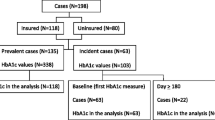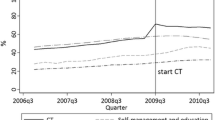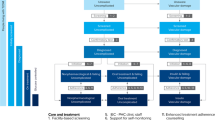Abstract
The burden of diabetes is more severe for minority populations than for the white population in the United States. Analysis of Medicare fee-for-service claims data revealed a significant disparity regarding screening for lipids between white and African-American Medicare beneficiaries with diabetes as measured by the biennial lipid profile indicator in New York State and the disparity was even greater in New York City. Thus IPRO, the Medicare New York State Quality Improvement Organization, launched a multifaceted quality improvement project to reduce the disparity, targeting African-American Medicare beneficiaries with diabetes in New York City and the providers who serve them. There was an absolute increase of 16.7% in the proportion of African-American beneficiaries with diabetes receiving a biennial lipid profile in the intervention areas and the disparity reduced by 9.8% between African-American and all eligible white beneficiaries in the intervention areas. Although it was not feasible to determine the direct impact of selected interventions on reducing the disparity, the interventions collectively appeared to be effective.
Similar content being viewed by others
References
Geiss LS, Herman WH, Smith PJ, National Diabetes Data Group. Diabetes in America. Bethesda, Md: National Institutes of Health, National Institutes of Diabetes and Digestive Kidney Diseases; 1995:233–257.
Hogan P, Dall T, Nikolov P (2003). Economic costs of diabetes in the US in 2002. Diabetes Care 26:917–932
Agency for Healthcare Research and Quality. Diabetes Disparities Among Racial and Ethnic Minorities. November 2001. AHRQ Publication No. 02-P007. Agency for Healthcare Quality and Research, Rockville, MD. http://www.ahrq.gov/research/diabdisp.htm
CDC/NCHS, National Vital Statistics System, Deaths, “Percent of Total Deaths, and Death Rates for the 15 Leading Causes of Death: United States and Each State, 1999–2001”. Available at http://www.cdc.gov/nchs/data/dvs/LCWK9_2001.pdf [accessed June 3, 2005]
Centers for Disease Control and Prevention (CDC). Behavioral Risk Factor Surveillance System Survey Data. Atlanta, Georgia: U.S. Department of Health and Human Services, Centers for Disease Control and Prevention, 2001. Available at http://apps.nccd.cdc.gov/brfss/display.asp?cat=DB&yr=2001&qkey=1364&state=NY [accessed June 3, 2005]
Fleming B, Greenfield S, Engelhau M, for the DQIP Group et al (2001). The Diabetes Quality Improvement Project: moving science into health policy to gain an edge on the diabetes epidemic. Diabetes Care 24:1815–1820
Beckman J, Creager M, Libby P (2002). Diabetes and atherosclerosis: epidemiology, pathophysiology, and management. JAMA 287:2570–2581
Karter AJ, Ferrara A, Liu JY, et al (2002). Ethnic disparities in diabetes complications in an insured population. JAMA 287:2519–2527
Cook CB, Erdman DM, Ryan GJ, et al (2000). The pattern of dyslipidemia among urban African-Americans with Type 2 diabetes. Diabetes Care 23:319–24
Huang ES, Meigs JB, Singer DE (2001) The effect of interventions to prevent cardiovascular disease in patients with type 2 diabetes. Am J Med 111:633–642
CDC Diabetes Cost-effectiveness Group (2002). Cost-effectiveness of intensive glycemic control, intensified hypertension control and serum cholesterol level reduction for type 2 diabetes. JAMA 287:2542–2551
Evans J. Initiative to address cardiac risk in diabetes. Int Med News. March 15, 2002:17
Cowie CC and Harris MI (1997) Ambulatory medical care for non-Hispanic whites, African-Americans, and Mexican-Americans with NIDDM in the U.S. Diabetes Care 20:142–147
Harris MI, Eastman RC, Cowie CC, Flegal KM and Eberhardt MS (1999). Racial and ethnic differences in glycemic control of adults with type 2 diabetes. Diabetes Care 22:403–408
Thorpe LE, Mostashari F, Berger DK, Cobb LK, Helgerson SD, Frieden TR (2003). Diabetes is Epidemic. NYC Vital Signs 2(1):1–4
Centers for Medicare & Medicaid Services. Outpatient Data Reports – Diabetes and Breast Cancer Screening Performance and Provider Profiles, April 1, 1999 – March 31, 2001 (unpublished).
DASPRO. Reducing Disparities in Health Outcomes: Effective and Promising Outpatient Interventions with Underserved Populations. Center for Healthcare Quality, Memphis, TN. May, 2002.
DASPRO. Cultural Competency Guide: Supporting Projects with Diverse Communities. A project development tool. Center for Healthcare Quality, Memphis, TN. July, 2002.
Beach MC, Cooper LA, Robinson KA, Price EG, Gary TL, Jenckes MW, Gozu A, Smarth C, Palacio A, Feuerstein CJ, Bass EB, Powe NR. Strategies for Improving Minority Healthcare Quality. Evidence Report/Technology Assessment No. 90. (Prepared by the John Hopkins University Evidence-based Practice Center, Baltimore, MD.) AHRQ Publication No. 04-E008-02. Rockville, MD: Agency for Healthcare Research and Quality. January 2004.
Prochaska JO, DiClemente CC, Norcross JC. In search of how people change: applications to addictive behaviors. Am Psychol. 1992:1102–1114.
Schillinger D, Grumbach K, Piette J, et al (2002). Association of health literacy with diabetes outcomes. JAMA 288:475–482
Brach C, Fraser I (2000). Can cultural competency reduce racial and ethnic health disparities? A review and conceptual model. Med Care Res Rev 57(suppl 1):181–217
Centers for Disease Control and Prevention. Strategies for reducing morbidity and mortality from diabetes through health-care system interventions and diabetes self-management education in community settings: a report on recommendations of the Task Force on Community Preventive Services. MMWR 2001;50(No. RR-16):[1–16].
Centers for Disease Control and Prevention (2002) Take Charge of Your Diabetes. 3rd edition. Atlanta, U.S. Department of Health and Human Services
Bach PB, Pham HH, Schrag D, Tate RC, Hargraves JL (2004). Primary care physicians who treat blacks and whites. N Engl J Med 351(6):575–84
Acknowledgments
The authors wish to thank Shelia McCullugh, Martha Carney, Michele Jones, Deborah Johnson-Ingram, Raymond Han, and Thomas Huang, all of IPRO, who carried out the practice interventions and computer programming support for this study. In addition, the authors thank Dr. Pascal James Imperato for his insightful comments on earlier versions of this paper. The analyses on which this publication is based were performed under Contract 500-02-NY-01 entitled “Utilization and Quality Control Peer Review Organization for the State of New York,” sponsored by the Centers for Medicare and Medicaid Services (CMS), Department of Health and Human Services. The content of this publication does not necessarily reflect the views or policies of the Department of Health and Human Services, nor does mention of trade names, commercial products, or organizations imply endorsement by the U.S. Government.
The authors assume full responsibility for the accuracy and completeness of the ideas presented. This article is a direct result of the Health Care Quality Improvement Program initiated by the Centers for Medicare and Medicaid Services, which has encouraged identification of quality improvement projects derived from analysis of patterns of care, and therefore requires no special funding on the part of this contractor. Ideas and contributions to the authors concerning experience in engaging with issues presented are welcomed.
Author information
Authors and Affiliations
Corresponding author
Additional information
Terry Mahotière, MD, MPH is a medical officer at IPRO; Katja Ocepek-Welikson, MPhil, is a project manager/analyst at IPRO, Maryanne B. Daley, RN, BSN, is a project manager at IPRO; Johan P. Byssainthe, MPH is a performance improvement coordinator at IPRO.
Rights and permissions
About this article
Cite this article
Mahotière, T., Ocepek-Welikson, K., Daley, M.B. et al. A Program to reduce the disparity in the rate of biennial lipid profiles between african-american and white medicare beneficiaries with diabetes mellitus in new york city. J Community Health 31, 263–288 (2006). https://doi.org/10.1007/s10900-006-9015-7
Published:
Issue Date:
DOI: https://doi.org/10.1007/s10900-006-9015-7




